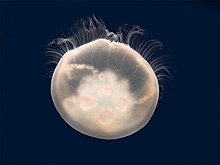Aurelia aurita
From Wikipedia, the free encyclopedia
| Aurelia aurita | |
|---|---|
 | |
| An adult Aurelia aurita | |
| Conservation status | |
Not evaluated (IUCN 3.1)
| |
| Scientific classification | |
| Kingdom: | Animalia |
| Phylum: | Cnidaria |
| Class: | Scyphozoa |
| Order: | Semaeostomeae |
| Family: | Ulmaridae |
| Genus: | Aurelia |
| Species: | A. aurita |
| Binomial name | |
| Aurelia aurita Linnaeus, 1758 | |
Aurelia aurita (also called the moon jelly, moon jellyfish, common jellyfish, or saucer jelly) is a widely studied species of the genus Aurelia. All species in the genus are closely related, and it is difficult to identify Aurelia medusae without genetic sampling; most of what follows applies equally to all species of the genus.
The medusa is translucent, usually about 25–40 cm in diameter, and can be recognized by its four horseshoe-shaped gonads, easily seen through the top of the bell. It feeds by collecting medusae, plankton and mollusks with its tentacles, and bringing them into its body for digestion. It is capable of only limited motion, and drifts with the current, even when swimming.
[edit]The genus Aurelia is found throughout most of the world's oceans, from the tropics to as far north as latitude 70°N and as far south as 40°S. The species Aurelia aurita is found along the eastern Atlantic coast of Northern Europe and the western Atlantic coast of North America in New England and Eastern Canada. In general, Aurelia is an inshore genus that can be found in estuaries and harbors. It lives in ocean water temperatures ranging from 6 °C to 31 °C; with optimum temperatures of 9 °C to 19 °C. A. aurita prefers temperate seas with consistent currents. It has been found in waters with salinity as low as 6 parts per thousand.Distribution
[edit]Feeding
A. aurita and other Aurelia species feed on plankton that includes organisms such as mollusks, crustaceans, tunicate larva, rotifers, young polychaetes, protozoans, diatoms, eggs, fish eggs, and other small organisms. Occasionally, they are also seen feeding on gelatinous zooplankton such as hydromedusae and ctenophores. Both the adult medusae and larvae of Aurelia have nematocysts to capture prey and also to protect themselves from predators.
The food is caught with its nematocyst-laden tentacles, tied with mucus, brought to the gastrovascular cavity, and passed into the cavity by ciliated action. There digestive enzymes from serous cell break down the food. There is little known about the requirements for particular vitamins and minerals, but due to the presence of some digestive enzymes, we can deduce in general that A. aurita can process carbohydrates, proteins and lipids.
[edit]Captivity
The invention of the Kreisel tank has made it possible to maintain these jellies in captivity.
[edit]Filtering Grid of Tentacles on the Bell Margin
|
|
|
[edit]Body system
Aurelia does not have respiratory parts such as gills, lungs, or trachea. Since it is a small organism, it respires by diffusingoxygen from water through the thin membrane covering its body. Within the gastrovascular cavity, low oxygenated water can be expelled and high oxygenated water can come in by ciliated action, thus increasing the diffusion of oxygen through cell. The large surface area membrane to volume ratio helps Aurelia to diffuse more oxygen and nutrients into the cells.
The basic body plan of Aurelia consists of several parts. The animal lacks respiratory, excretory, and circulatory systems. The adult medusa ofAurelia, with a transparent look, has an umbrella margin membrane and tentacles that are attached to the bottom. It has four bright gonads that are under the stomach. Food travels through the muscular manubrium while the radial canals help disperse the food. There is a middle layer ofmesoglea, gastrodervascular cavity with gastrodermis, and epidermis. There is a nerve net that is responsible for contractions in swimming muscles and feeding responses. Adult medusa can have a diameter up to 40 cm. The medusae are either male or female. The young larval stage, a planula, has small ciliated cells and after swimming freely in the plankton for a day or more, settles on an appropriate substrate, where it changes into a special type of polyp called a "scyphistoma", which divides by strobilation into small ephyrae that swim off to grow up asmedusae.[9][10] There is an increasing size from starting stage planula to ephyra, from less than 1 mm in the planula stage, up to about 1 cm in ephyra stage, and then to several cm in diameter in the medusa stage.
[edit]Predators
Aurelia aurita is known to be eaten by a wide variety of predators including the Ocean Sunfish (Mola mola), the Leatherback Sea Turtle (Dermochelys coriacea), the scyphomedusa Phacellophora camtschatica, and a very large hydromedusa (Aequorea victoria). Moon jellies are also fed upon by sea birds, which may be more interested in the amphipods and other small arthropods that frequent the bells of Aurelia, but in any case, birds do some substantial amount of damage to these jellyfish that often are found just at the surface of bays.
Aurelia jellyfish naturally die after living and reproducing for several months. It is probably rare for these moon jellies to live more than about six months in the wild, although specimens cared for in public aquarium exhibits typically live several to many years. In the wild, the warm water at the end of summer combines with exhaustive daily reproduction and lower natural levels of food for tissue repair, leaving these jellyfish more susceptible to bacterial and other disease problems that likely lead to the demise of most individuals. Such problems are responsible for the demise of many smaller species of jellyfish. In 1997, Arai summarized that seasonal reproduction leaves the gonads open to infection and degradation.
Some metazoan parasites attack Aurelia aurita, as well as most other species of jellyfish.








Tidak ada komentar:
Posting Komentar